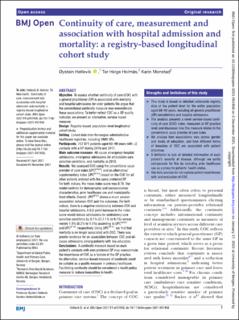| dc.contributor.author | Hetlevik, Øystein | |
| dc.contributor.author | Holmås, Tor Helge | |
| dc.contributor.author | Monstad, Karin | |
| dc.date.accessioned | 2022-02-21T13:05:02Z | |
| dc.date.available | 2022-02-21T13:05:02Z | |
| dc.date.created | 2022-01-04T11:37:41Z | |
| dc.date.issued | 2021 | |
| dc.identifier.issn | 2044-6055 | |
| dc.identifier.uri | https://hdl.handle.net/11250/2980539 | |
| dc.description.abstract | Objective
To assess whether continuity of care (COC) with a general practitioner (GP) is associated with mortality and hospital admissions for older patients We argue that the conventional continuity measure may overestimate these associations. To better reflect COC as a GP quality indicator, we present an alternative, service-based measure.
Design
Registry-based, population-level longitudinal cohort study.
Setting
Linked data from Norwegian administrative healthcare registries, including 3989 GPs.
Participants
757 873 patients aged 60–90 years with ≥2 contacts with a GP during 2016 and 2017.
Main outcome measure
All-cause emergency hospital admissions, emergency admissions for ambulatory care sensitive conditions, and mortality, in 2018.
Results
We assessed COC using the conventional usual provider of care index (UPCpatient) and an alternative/supplementary index (UPCGP list) based on the COC for all other patients enlisted with the same preferred GP.
For both indices, the mean index score was 0.78. Our model controls for demographic and socioeconomic characteristics, prior healthcare use and municipality-fixed effects. Overall, UPCGP list shows a much weaker association between COC and the outcomes. For both indices, there is a negative relationship between COC and hospital admissions. A 0.2-point increase in the index score would reduce admissions for ambulatory care sensitive conditions by 8.1% (CI 7.1% to 9.1%) versus merely 1.9% (0.2% to 3.5%) according to UPCpatient and UPCGP list, respectively. Using UPCGP list, we find that mortality is no longer associated with COC. There was greater evidence for an association between COC and all-cause admissions among patients with low education.
Conclusions
A continuity measure based on each patient’s contacts with own preferred GP may overestimate the importance of COC as a feature of the GP practice. An alternative, service-based measure of continuity could be suitable as a quality measure in primary healthcare. Facilitating continuity should be considered a health policy measure to reduce inequalities in health. | en_US |
| dc.language.iso | eng | en_US |
| dc.publisher | BMJ Publishing Group | en_US |
| dc.rights | Navngivelse 4.0 Internasjonal | * |
| dc.rights.uri | http://creativecommons.org/licenses/by/4.0/deed.no | * |
| dc.title | Continuity of care, measurement and association with hospital admission and mortality: a registry-based longitudinal cohort study | en_US |
| dc.type | Journal article | en_US |
| dc.type | Peer reviewed | en_US |
| dc.description.version | publishedVersion | en_US |
| dc.rights.holder | Copyright Author(s) (or their employer(s)) 2021. | en_US |
| dc.source.articlenumber | e051958 | en_US |
| cristin.ispublished | true | |
| cristin.fulltext | original | |
| cristin.qualitycode | 1 | |
| dc.identifier.doi | 10.1136/bmjopen-2021-051958 | |
| dc.identifier.cristin | 1974216 | |
| dc.source.journal | BMJ Open | en_US |
| dc.identifier.citation | BMJ Open. 2021, 11 (12), e051958. | en_US |
| dc.source.volume | 11 | en_US |
| dc.source.issue | 12 | en_US |

